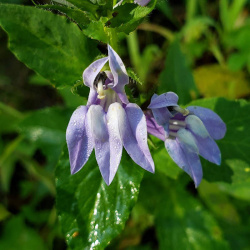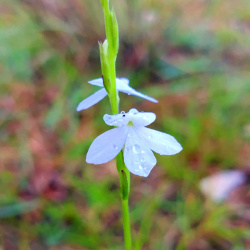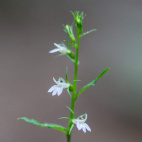Color
Availability
USDA Zone
Region
Type
Duration
Season
Germination
Soil
Sunlight
Height
Narrow Your Search
Color
Availability
USDA Zone
Region
Type
Duration
Season
Germination
Soil
Sunlight
Height
Wildflowers - Lobelia Seeds
The Lobelias that you see in your local greenhouse are a little different than these native Lobelias. These are sometimes considered to be biennials, but we have grown fields of Blue Lobelia and Cardinal flower that will bloom and produce seeds for a few years. So they seem to be more of a short lived perennial, and show up in the early years of a prairie or wetland restoration. They produce loads of microscopic orange seeds, that will lie dormant until they get an opening to start growing again. The Cardinal Flowers are one of the reddest reds, and are loved by hummingbirds and other pollinators. Most perennial Lobelia seeds like moisture, making them ideal candidates for wetland areas like stream banks, swamps, or near ponds.
-
 Indian Tobacco Seeds
Lobelia inflata
Though once used as a native medicinal remedy, this pale purple wildflower is best enjoyed visually. This flower is a native annual that readily reseeds for the following growing season.Quick View$3.75 Pkt - $100.00 / Oz
Indian Tobacco Seeds
Lobelia inflata
Though once used as a native medicinal remedy, this pale purple wildflower is best enjoyed visually. This flower is a native annual that readily reseeds for the following growing season.Quick View$3.75 Pkt - $100.00 / Oz -
 Pale Spiked Lobelia Seeds
Lobelia spicata
Developing on willowy stems, these pale flowers add delicate beauty to any native planting. This perennial is not as showy as some other Lobelias, but still attracts hummingbirds and butterflies with its tubular flowers.Quick View$3.96 Pkt - $240.00 / Oz
Pale Spiked Lobelia Seeds
Lobelia spicata
Developing on willowy stems, these pale flowers add delicate beauty to any native planting. This perennial is not as showy as some other Lobelias, but still attracts hummingbirds and butterflies with its tubular flowers.Quick View$3.96 Pkt - $240.00 / Oz
The Lobelias that you see in your local greenhouse are a little different than these native Lobelias. These are sometimes considered to be biennials, but we have grown fields of Blue Lobelia and Cardinal flower that will bloom and produce seeds for a few years. So they seem to be more of a short lived perennial, and show up in the early years of a prairie or wetland restoration. They produce loads of microscopic orange seeds, that will lie dormant until they get an opening to start growing again. The Cardinal Flowers are one of the reddest reds, and are loved by hummingbirds and other pollinators. Most perennial Lobelia seeds like moisture, making them ideal candidates for wetland areas like stream banks, swamps, or near ponds.








